Papers by Aleš Oblak

Philosophical Psychology, 2024
There are profound methodological challenges facing microdosing research. One way we can address ... more There are profound methodological challenges facing microdosing research. One way we can address some of these methodological issues is by understanding how psilocybin microdosing fits in the broader existential context of people's lives. We recruited participants who underwent psilocybin microdosing on their own and consented to being monitored for harm mitigation purposes. We combined momentary ecological assessment and detailed retrospective interviews. Participants reported loosening of mental structures (i.e., less intense strength of thoughts, tangential stream of consciousness), increased salience of external stimuli (varyingly associated with greater interest in otherwise mundane activities, as well as sensory overload), an increase in flexible cognition, a decrease in stable cognition, and various ego-dystonic contents. Highly structured environments were conducive to positive appraisal of experiences and vice versa. Momentary ecological assessment and retrospective interviews yielded differing accounts of microdosing experience. We relate our findings to stable and flexible cognition, as well as the notion of salience. We point out the necessity for systematic mixed methods studies to better characterize the lived experience of taking low doses of psilocybin.
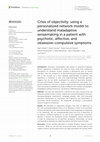
Frontiers in Psychology, 2024
Introduction: Psychiatric comorbidities have proven a consistent challenge. Recent approaches emp... more Introduction: Psychiatric comorbidities have proven a consistent challenge. Recent approaches emphasize the need to move away from categorical descriptions of symptom clusters towards a dimensional view of mental disorders. From the perspective of phenomenological psychopathology, this shift is not enough, as a more detailed understanding of patients’ lived experience is necessary as well. One phenomenology-informed approach suggests that we can better understand the nature of psychiatric disorders through personalized network models, a comprehensive description of a person’s lifeworld in the form of salient nodes and the relationships between them. We present a detailed case study of a patient with multiple comorbidities, maladaptive coping mechanisms, and adverse childhood experiences.
Methods: The case was followed for a period of two years, during which we collected multiple streams of data, ranging from phenomenological interviews,neuropsychological assessments, language analysis, and semi-structured interviews (Examination of Anomalous Self Experience and Examination of Anomalous World Experience). We analytically constructed a personalized network model of his lifeworld.
Results: We identified an experiential category “the crisis of objectivity” as
the core psychopathological theme of his lifeworld. It refers to his persistent mistrust towards any information that he obtains that he appraises as originating in his subjectivity. We can developmentally trace the crisis of objectivity to his adverse childhood experience, as well as him experiencing a psychotic episode in earnest. He developed various maladaptive coping mechanisms in order to compensate for his psychotic symptoms. Interestingly, we found correspondence between his subjective reports and other sources of data.
Discussion: Hernan exhibits difficulties in multiple Research Domain Criteria constructs. While we can say that social sensorimotor, positive valence, and negative valence systems dysfunctions are likely associated with primary deficit (originating in his adverse childhood experience), his cognitive symptoms may be tied to his maladaptive coping mechanisms (although, they might be related to his primary disorder as well).

Viceversa, 2024
Depression is a multifaceted psychiatric disorder that can be characterized by various symptom di... more Depression is a multifaceted psychiatric disorder that can be characterized by various symptom dimensions. Considering the prevalence and societal burden of depression, it is essential that validated instruments for diagnosis are used. In Slovenian cultural environment, only a few psychological questionnaires have been validated. Furthermore, existing questionnaires do not differentiate between different dimensions of depression. The Inventory of Depressive Symptomatology (IDS-30) is a commonly used questionnaire for screening depression that accounts for all symptom dimensions specified by the Diagnostic and Statistical Manual of Mental Disorders. The self-report version of IDS-30 has previously been used in Slovenia, demonstrating its convergent validity. However, to date, its structural validity has not been tested. The present study investigates the factor structure of IDS-30. We replicated the three-factor structure consisting of mood/cognition, anxiety/somatics, and sleep disturbances that is widely reported in the literature. These dimensions of depression are supported by the neurobiological literature.
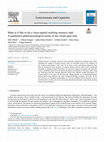
Consciousness and Cognition, 2024
Working memory is typically measured with specifically designed psychological tasks. When evaluat... more Working memory is typically measured with specifically designed psychological tasks. When evaluating the validity of working memory tasks, we commonly focus on the reliability of the outcome measurements. Only rarely do we focus on how participants experience these tasks. Accounting for lived experience of working memory task may help us better understand variability in working memory performance and conscious experience in general. We replicated recently established protocols for the phenomenological investigation of working memory using the visual span task. We collected subjective reports from eighteen healthy participants (10 women) aged 21 to 35 years. We observed that working memory can be phenomenologically characterized at three different time scales: background feelings, strategies, and tactics. On the level of tactics, we identified transmodality (i.e., how one modality of lived experience can be transformed into another one) as the central phenomenological dynamic at play during working memory task performance.

Journal of Consciousness Studies, 2024
Many methodologies for systematic study of lived experience have been proposed in recent decades.... more Many methodologies for systematic study of lived experience have been proposed in recent decades. These methods are typically calibrated in terms of the depth and complexity of data collection and whether they consider reports on pre-reflective experience admissible. Even though it has been shown that lived experience occurs at different timescales (elementary, integrative, narrative), contemporary methods tend to focus on momentary experience. We trace the focus on momentary experience to the current cultural milieu and attitudes in the history of psychology. We point out the need for studying temporally extended experiences in the field of psychopathology. We propose that lived experience at different timescales are nested within each other and that this principle can be used to organize data collected with qualitative methods for the study of experience. We suggest that temporally extended experience occur at the narrative level of description (i.e., they consist of experiential reports and sense-making).

Frontiers in Psychiatry, 2023
Introduction: Patients with schizophrenia typically exhibit deficits in working memory (WM) assoc... more Introduction: Patients with schizophrenia typically exhibit deficits in working memory (WM) associated with abnormalities in brain activity. Alterations in the encoding, maintenance and retrieval phases of sequential WM tasks are well established. However, due to the heterogeneity of symptoms and complexity of its neurophysiological underpinnings, differential diagnosis remains a challenge. We conducted an electroencephalographic (EEG) study during a visualWM task in fifteen schizophrenia patients and fifteen healthy controls. We hypothesized that EEG abnormalities during the task could be identified, and patients successfully classified by an interpretable machine learning algorithm.
Methods: We tested a custom dense attention network (DAN) machine learning model to discriminate patients from control subjects and compared its performance with simpler and more commonly used machine learning models. Additionally, we analyzed behavioral performance, event-related EEG potentials, and time-frequency representations of the evoked responses to further characterize abnormalities in patients during WM.
Results: The DAN model was significantly accurate in discriminating patients from healthy controls, ACC = 0.69, SD = 0.05. There were no significant differences between groups, conditions, or their interaction in behavioral performance or event-related potentials. However, patients showed significantly lower alpha suppression in the task preparation, memory encoding, maintenance, and retrieval phases F(1,28) = 5.93, p = 0.022, !2 = 0.149. Further analysis revealed that the two highest peaks in the attention value vector of the DAN model overlapped in time with the preparation and memory retrieval phases, as well as with two of the four significant time-frequency ROIs.
Discussion: These results highlight the potential utility of interpretable machine learning algorithms as an aid in diagnosis of schizophrenia and other psychiatric disorders presenting oscillatory abnormalities
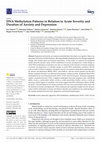
Current Issues in Molecular Biology, 2023
Depression and anxiety are common mental disorders that often occur together. Stress is an import... more Depression and anxiety are common mental disorders that often occur together. Stress is an important risk factor for both disorders, affecting pathophysiological processes through epigenetic changes that mediate gene–environment interactions. In this study, we explored two proposed models about the dynamic nature of DNA methylation in anxiety and depression: a stable change, in which DNA methylation accumulates over time as a function of the duration of clinical symptoms of anxiety and depression, or a flexible change, in which DNA methylation correlates with the acute severity of clinical symptoms. Symptom severity was assessed using clinical questionnaires for anxiety and depression (BDI-II, IDS-C, and HAM-A), and the current episode and the total lifetime symptom duration was obtained from patients’ medical records. Peripheral blood DNA methylation levels were determined for the BDNF, COMT, and SLC6A4 genes. We found a significant negative correlation between COMT_1 amplicon methylation and acute symptom scores, with BDI-II (R(22) = 0.190, p = 0.033), IDS-C (R(22) = 0.199, p = 0.029), and HAM-A (R(22) = 0.231, p = 0.018) all showing a similar degree of correlation. Our results suggest that DNA methylation follows flexible dynamics, with methylation levels closely associated with acute clinical presentation rather than with the duration of anxiety and depression. These results provide important insights into the dynamic nature of DNA methylation in anxiety and affective disorders and ontribute to our understanding of the complex interplay between stress, epigenetics, and individual phenotype.

Cognitive Science, 2023
The study of individual experience during the performance of a psychological task using a phenome... more The study of individual experience during the performance of a psychological task using a phenomenological approach is a relatively new area of research. The aim of this paper was to combine first-and third-person approaches to investigate whether the strategies individuals use during a working memory task are associated with specific task conditions, whether the strategies combine to form stable patterns, and whether the use of specific strategies is related to task accuracy. Thirty-one participants took part in an experiment in which they were instructed to remember colors, orientations, or positions of stimuli presented in a change detection task. After every 7th-15th trial, participants took part in an in-depth phenomenological interview in which they described their experiences during the trial that immediately preceded the interview. Qualitative analysis revealed a set of 18 strategies that participants used while performing the task, which we divided into active and passive strategies of encoding, maintenance, and retrieval. Quantitative analysis revealed that while many strategies were used in all task conditions, some strategies and their combinations may be better suited to the specific task demands, while others are more general in nature. The results also suggest a distinction between
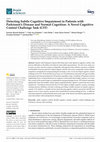
Brain Sciences , 2023
Patients with Parkinson’s disease (PD) often show early deficits in cognitive control, with prima... more Patients with Parkinson’s disease (PD) often show early deficits in cognitive control, with primary difficulties in flexibility and relatively intact stable representations. The aim of our study was to assess executive function using an ecologically valid approach that combines measures of stability and flexibility. Fourteen patients without cognitive deficits and sixteen comparable control subjects completed a standardized neuropsychological test battery and a newly developed cognitive control challenge task (C3T). We found that the accuracy of C3T performance decreased with age in healthy participants and remained impaired in PD patients regardless of age. In addition, PD patients showed significantly lower overall performance for cognitive control tasks than healthy controls, even when they scored in the normal range on standardized neuropsychological tests. PD Patients responded significantly faster than healthy control subjects regarding flexible ognitive control tasks due to their impulsivity. Correlations showed that the C3T task targets multiple cognitive systems, including working memory, inhibition, and task switching, providing a reliable easure of complex cognitive control. C3T could be a valuable tool for characterizing cognitive deficits associated with PD and appears to be a more sensitive measure than standardized europsychological tests. A different assessment approach could potentially detect early signs of the disease nd identify opportunities for early intervention with neuroprotective therapies
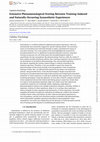
Collabra: Psychology, 2023
Synaesthesia is a condition defined by additional perceptual experiences, which are automatically... more Synaesthesia is a condition defined by additional perceptual experiences, which are automatically and consistently triggered by specific inducing stimuli. The associative nature of synaesthesia has motivated attempts to induce synaesthesia by means of associative learning. Two recent studies of this kind highlighted the potential for perceptual plasticity even in adulthood, by demonstrating that extensive associative training can generate not only behavioural and neurophysiological markers of synaesthesia, but also synaesthesia-like phenomenology. However, while the results of these studies provided tantalising evidence that a learning component may be involved in the development of synesthetic phenomenology, they only provided superficial descriptions regarding the training-related changes in induced synaesthesia-like (Induced) experience. Therefore, it was not possible to assess how closely the phenomenology of Induced and naturally occurring grapheme-colour synaesthesia (Lifelong) overlap. Here, we addressed this question by providing a new qualitative analysis, using grounded theory, of the phenomenological changes associated with learning new perceptual phenomenology (Induced group) and comparing the descriptive similarities in colour experience to equivalent qualitative data acquired from a new group of Lifelong participants. Using this approach, we were able to directly compare associated colour experiences between the Induced and Lifelong group to assess how closely these two types of novel perceptual experience align. Our results reveal that induced and synaesthetic experience are remarkably similar, displaying a high degree of phenomenological overlap across multiple experiential categories, including: stability of experience, location of colour experience, shape of co-occurring colour experience, relative strength of colour experience and automaticity of colour experience. Our results exemplify the benefits of qualitative methods by providing new evidence that intensive training of letter-colour associations can alter conscious perceptual experiences in non-synaesthetes, and that such alterations produce synaesthesia-like phenomenology, which substantially resembles experiences described in natural grapheme-colour synaesthesia. Our results have implications for the plasticity of visual perception and the role of learning and development in establishing perceptual traits.

Current Issues in Molecular Biology, 2023
Polycystic ovary syndrome (PCOS) is an endocrine and metabolic disorder affecting women of reprod... more Polycystic ovary syndrome (PCOS) is an endocrine and metabolic disorder affecting women of reproductive age. Research has shown that epigenetic alterations such as DNA methylation may play a role in the development and progression of abnormal ovarian function and metabolic disorders in PCOS. Studies have identified specific genes (related with insulin signaling and steroid hormone metabolism) that are methylated in women with PCOS. DNA methylation appears to respond to various interventions aimed at altering health and lifestyle factors. We tested the efficacy of a mindfulness-based stress reduction program (MBSR) in PCOS patients. We examined its effects on anthropometric measurements, mental health and wellbeing, and alterations in DNA methylation in peripheral blood. MBSR was associated with a reduction in body mass index, waist circumference and blood glucose level, an improvement in subjectively perceived general health, emotional role limitation, and levels of pain, as well as...

The Qualitative Report, 2022
In cognitive science, it is unclear what precisely presence (both in the sense of objecthood and ... more In cognitive science, it is unclear what precisely presence (both in the sense of objecthood and immersion) refers to in lived experience. The present study addresses the research question of what the relationship between presence is and lived space. A hundred and seventeen phenomenological interviews were conducted with 14 participants. We sampled their experience in a transdiagnostic manner. That is, we observed how the experience of presence changes both in circumstances appraised as positive (e.g., sexual intimacy) and negative (e.g., psychopathology). Our grounded theory suggests that presence is a phenomenon that is comprised of all available sensory knowledge, however, it itself is not present in any one sensory modality. Presence takes the form of a disembodied sense of solidity. Our findings can be related to the notion of transmodality in contemporary qualitative phenomenology (i.e., the idea that there are some aspects of experience that can be readily translated from one sensory modality to another. Further, how presence (in its capacity as immersion) is related to lived space can shed further light on the formation of delusions, suggesting that it is based on sensory alterations rather than changes in belief. Finally, the observation that presence as it appears in lived space need not perfectly correspond to the objective situation, can elucidate extant discussion on whether presence is an amodal aspect of consciousness.
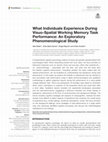
Frontiers in Psychology, 2022
In experimental cognitive psychology, objects of inquiry are typically operationalized with psych... more In experimental cognitive psychology, objects of inquiry are typically operationalized with psychological tasks. When interpreting results from such tasks, we focus primarily on behavioral measures such as reaction times and accuracy rather than experiences – i.e., phenomenology – associated with the task, and posit that the tasks elicit the desired cognitive phenomenon. Evaluating whether the tasks indeed elicit the desired phenomenon can be facilitated by understanding the experience during task performance. In this paper we explore the breadth of experiences that are elicited by and accompany task performance using in-depth phenomenological and qualitative methodology to gather subjective reports during the performance of a visuo-spatial change detection task. Thirty-one participants (18 females) were asked to remember either colors, orientations or positions of the presented stimuli and recall them after a short delay. Qualitative reports revealed rich experiential landscapes associated with the task-performance, suggesting a distinction between two broad classes of experience: phenomena at the front of consciousness and background feelings. The former includes cognitive strategies and aspects of metacognition, whereas the latter include more difficult-to-detect aspects of experience that comprise the overall sense of experience (e.g., bodily feelings, emotional atmosphere, mood). We focus primarily on the background feelings, since strategies of task-performance to a large extent map onto previously identified cognitive processes and discuss the methodological implications of our findings.
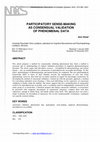
Interdisciplinary Description of Complex Systems, 2021
This article proposes a method for consensually validating phenomenal data. Such a method is nece... more This article proposes a method for consensually validating phenomenal data. Such a method is necessary due to underreporting of explicit validation procedures in empirical phenomenological literature. The article argues that descriptive sciencesexemplified by phenomenology and natural historyrely on nominalization for construction of intersubjectively accessible knowledge. To this effect, epistemologies of phenomenology and natural history are compared. The two epistemological frameworks differ in terms of their attitudes towards the interpretation of texts and visual epistemology, however, they both rely on eidetic intuition of experts for knowledge construction. In developing the method of consensual validation, I started out with the prismatic approach, a method for researching embodied social dynamics. I then used debriefings on the experience of consensual validation to further refine the method. The article suggests that for a nominalization of experiential world to be intersubjectively accessible, such a vocabulary must be independently constructed by the entire group of co-researchers. I therefore propose that during consensual validation, co-researchers be presented with composite descriptions of experiential categories, compare them with their experience, attempt to falsify them, and finally jointly name them. This approach does not yield a single vocabulary for description of experience, but several commensurable vocabularies, contingent on a specific research setting.

Phainomena, 2021
Phenomenological investigations of participants with grapheme-color synesthesia—a condition where... more Phenomenological investigations of participants with grapheme-color synesthesia—a condition wherein an inducer consistently and automatically triggers an additional concurrent perceptual experience—have revealed an apparent paradox. Namely, they describe the automaticity of their synesthetic experiences as being both willed and automatic. Here, we apply in-depth interviews and signal-contingent experience sampling to investigate the lived experience of a single case (HR) of synesthesia to address this paradox. Our results suggest that for HR an inducer elicits a non-visual, spatially-localized, immediate, and intuitive knowledge about the concurrent. Critically, HR reports that in order to experience the concurrent visually, she must perform a specific mental gesture. We suggest that reporting on the former yields descriptions of concurrent experience as being automatic, and reporting on the latter yields descriptions of concurrent experience as being willful. Our findings demonstrate the need for detailed phenomenological investigations of the experience of synesthesia, in order to develop more accurate descriptions of this experience
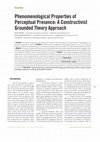
Constructivist Foundations , 2021
Context • Perceptual presence is the experience wherein veridical objects are experienced as belo... more Context • Perceptual presence is the experience wherein veridical objects are experienced as belonging to an observer-independent world. > Problem • Experimental investigations of perceptual presence are rare. It may be that the standard conceptualizations of perceptual presence are not suitable for experimental operationalization. > Method • Using the framework of constructivist grounded theory, three observational perspectives (engaged, nearecological, and receptive) are employed to discern method-invariant phenomenological properties of perceptual presence. Inductive coding is used as a main analytical instrument. > Results • Four phenomenological properties of perceptual presence are constructed: perceptually present objects (a) appear inexhaustible in the amount of modal detail they contain; (b) are experienced as a particular arrangement of lived space; (c) allow for some and preclude other bodily interactions; and (d) are marked by a specific feeling of coupling. > Implications • Descriptions of lived experience of perceptual presence, in particular the structure of lived space, may further allow for the design of experiments that more precisely target individual properties of this phenomenon. > Constructivist content • Perceptual presence is conceived of as one of the main properties of consciousness: it is the experience of objects as belonging to an observer-independent world. Phenomenological properties contributing to how this sense of veridicality is constructed are presented.
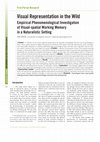
Constructivist Foundations, 2020
> Context • In sciences of the mind, cognitive phenomena are typically investigated with the use ... more > Context • In sciences of the mind, cognitive phenomena are typically investigated with the use of psychological tasks. These usually represent highly constrained environments that isolate and make phenomena under investigation measurable. However, it is poorly understood how psychological tasks constrain one's cognition and, to a certain extent, construct their own object of inquiry. > Problem • I address the question of how visual-spatial working memory is constrained differently in a naturalistic setting, as compared to when measured with psychological tasks. Specifically, can we observe principled and empirical support for the claim that psychological tasks to a certain extent construct the phenomena they purportedly measure? > Method • I employ an empirical phenomenological approach that combines the methodological and analytical framework of constructivist grounded theory with contemporary approaches to the scientific study of experience, to gather phenomenal data on visual working memory in a naturalistic setting-a drawing task. > Results • The drawing task elicits visual-spatial working memory as a type of visual-motor behavior with rare instances of mnemonic representations taking the form of language. Importantly, my empirical findings show that investigating cognitive phenomena in naturalistic settings yields constructs that are different from phenomena elicited in a laboratory setting. > Implications • The findings suggest that investigating the mind solely with psychological tasks provides an incomplete picture of the phenomena under investigation. > Constructivist content • I outline empirical data that points to how, under different constraints from the environment , not only do we conceptualize cognitive phenomena according to different theoretical constructs, but our cognitive system deploys different strategies to solve the task at hand.
Journal of Consciousness Studies, 2019
We present the shortened version of the codebook used to analyze the acquired samples of experien... more We present the shortened version of the codebook used to analyze the acquired samples of experience. See Figure 3 for an overview of categories at different levels of coding, and Figure 4 for an example of an original, uncut codebook entry (for the II-order category Processing content). Due to the spatial limitations, the categories are presented in a brief and eclectic manner: some of them only with the definition, others only with examples, and some whose names are self-explanatory enough even without any additional explanation. The orders of coding are indicated by Roman numerals next to the category names for orders III and IV; the names of II-order categories are italicized.
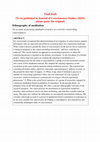
Journal of Consciousness Studies, 2019
It is increasingly recognized that phenomenological investigation of consciousness requires parti... more It is increasingly recognized that phenomenological investigation of consciousness requires participants who are interested and skilled in examining their own experiential landscape. What would it mean to ground the study of consciousness on the person whose experience is being investigated as the central measuring instrument-and how could that be achieved? This article explores an approach to researching experience in which the experiencing person is regarded as the primary investigator. As the first phase of a broader project, whose long-term goal is to examine the potential of meditation as a methodological tool for the study of consciousness, a group of seven researchers carried out a series of five meditation retreats. We sampled the ongoing experience of the researchers at the same random moments during meditation practice. The acquired data consisting of journal entries, interview transcripts, and participatory analysis sessions set the ground for three lines of inquiry: (1) What, if any, kind of meditative practice is suitable for researching experience? How can it be cultivated? (2) Can a group of researchers skilled in meditation systematically investigate selected experiential phenomena? (3) What is the actual lived experience of a group of researchers engaged in continuous meditation-based examination of experience? In the present article, we primarily focus on the third question. We offer a concrete ethnographic overview of our research enterprise. The report presents the distribution of experiential modalities, describes what meditators tried to do when meditating, and what they actually ended up doing. The paper also outlines the difficulties we encountered and potential solutions. We consider a thorough account of a pursuit of meditation-based examination of experience to be the most suitable first step towards developing a contemplative, non-naturalized, and existentially meaningful study of consciousness.
Commentaries and Responses by Aleš Oblak
Constructivist Foundation, 2022
I offer a critical reading of Petri and Gromadzki's target article, suggesting that it construct... more I offer a critical reading of Petri and Gromadzki's target article, suggesting that it constructs a strawman neurophenomenology. I argue that the article is an exemplar of an overabundance of publications that hyper-focus on conceptual questions about neurophenomenology, which ultimately serve to detract from conducting neurophenomenological studies. Rather than introducing novel first-person methods in the form of somatic practices, I suggest that formal theory construction might be a better route towards iterative improvement of neurophenomenology.











Uploads
Papers by Aleš Oblak
Methods: The case was followed for a period of two years, during which we collected multiple streams of data, ranging from phenomenological interviews,neuropsychological assessments, language analysis, and semi-structured interviews (Examination of Anomalous Self Experience and Examination of Anomalous World Experience). We analytically constructed a personalized network model of his lifeworld.
Results: We identified an experiential category “the crisis of objectivity” as
the core psychopathological theme of his lifeworld. It refers to his persistent mistrust towards any information that he obtains that he appraises as originating in his subjectivity. We can developmentally trace the crisis of objectivity to his adverse childhood experience, as well as him experiencing a psychotic episode in earnest. He developed various maladaptive coping mechanisms in order to compensate for his psychotic symptoms. Interestingly, we found correspondence between his subjective reports and other sources of data.
Discussion: Hernan exhibits difficulties in multiple Research Domain Criteria constructs. While we can say that social sensorimotor, positive valence, and negative valence systems dysfunctions are likely associated with primary deficit (originating in his adverse childhood experience), his cognitive symptoms may be tied to his maladaptive coping mechanisms (although, they might be related to his primary disorder as well).
Methods: We tested a custom dense attention network (DAN) machine learning model to discriminate patients from control subjects and compared its performance with simpler and more commonly used machine learning models. Additionally, we analyzed behavioral performance, event-related EEG potentials, and time-frequency representations of the evoked responses to further characterize abnormalities in patients during WM.
Results: The DAN model was significantly accurate in discriminating patients from healthy controls, ACC = 0.69, SD = 0.05. There were no significant differences between groups, conditions, or their interaction in behavioral performance or event-related potentials. However, patients showed significantly lower alpha suppression in the task preparation, memory encoding, maintenance, and retrieval phases F(1,28) = 5.93, p = 0.022, !2 = 0.149. Further analysis revealed that the two highest peaks in the attention value vector of the DAN model overlapped in time with the preparation and memory retrieval phases, as well as with two of the four significant time-frequency ROIs.
Discussion: These results highlight the potential utility of interpretable machine learning algorithms as an aid in diagnosis of schizophrenia and other psychiatric disorders presenting oscillatory abnormalities
Commentaries and Responses by Aleš Oblak
Methods: The case was followed for a period of two years, during which we collected multiple streams of data, ranging from phenomenological interviews,neuropsychological assessments, language analysis, and semi-structured interviews (Examination of Anomalous Self Experience and Examination of Anomalous World Experience). We analytically constructed a personalized network model of his lifeworld.
Results: We identified an experiential category “the crisis of objectivity” as
the core psychopathological theme of his lifeworld. It refers to his persistent mistrust towards any information that he obtains that he appraises as originating in his subjectivity. We can developmentally trace the crisis of objectivity to his adverse childhood experience, as well as him experiencing a psychotic episode in earnest. He developed various maladaptive coping mechanisms in order to compensate for his psychotic symptoms. Interestingly, we found correspondence between his subjective reports and other sources of data.
Discussion: Hernan exhibits difficulties in multiple Research Domain Criteria constructs. While we can say that social sensorimotor, positive valence, and negative valence systems dysfunctions are likely associated with primary deficit (originating in his adverse childhood experience), his cognitive symptoms may be tied to his maladaptive coping mechanisms (although, they might be related to his primary disorder as well).
Methods: We tested a custom dense attention network (DAN) machine learning model to discriminate patients from control subjects and compared its performance with simpler and more commonly used machine learning models. Additionally, we analyzed behavioral performance, event-related EEG potentials, and time-frequency representations of the evoked responses to further characterize abnormalities in patients during WM.
Results: The DAN model was significantly accurate in discriminating patients from healthy controls, ACC = 0.69, SD = 0.05. There were no significant differences between groups, conditions, or their interaction in behavioral performance or event-related potentials. However, patients showed significantly lower alpha suppression in the task preparation, memory encoding, maintenance, and retrieval phases F(1,28) = 5.93, p = 0.022, !2 = 0.149. Further analysis revealed that the two highest peaks in the attention value vector of the DAN model overlapped in time with the preparation and memory retrieval phases, as well as with two of the four significant time-frequency ROIs.
Discussion: These results highlight the potential utility of interpretable machine learning algorithms as an aid in diagnosis of schizophrenia and other psychiatric disorders presenting oscillatory abnormalities
inquiries into the functional localization of visuospatial
working memory (VSWM). Using functional
magnetic resonance imaging (fMRI), we have
attempted to reaffirm some of the hypotheses,
previously established when it comes to the way
the prefrontal cortex (PFC) codifies different
types of information about objects, when they
are being manipulated by the visual working
memory. Depending on the demands of the task,
the PFC can encode information either in a domain-
general or domain-specific way [1]. We
looked into how processing of integrated stimuli
differs from segregated stimuli. EEG studies
have shown that the contralateral delay activation
(CDA) - a wave of activation seen in such cognitive
functions as attention - rises with each new
stimulus held in our working memory, reaching
an asymptote at 3 – 4 stimuli, the maximum
number of objects we can maintain [2]. The
question here is whether an integrated stimulus
is perceived as a single item or its constituent
features represent unique objects in and of
themselves, and what are the neural correlates
of this processing.
The document includes powerpoint slides and script of the talk.
for the integration problem in psychiatry. I compare her enactive solution to constructivist approaches to psychopathology. I identify a blind spot in the proposed enactive framework for psychiatry and potential for future research in the role of extended cognition.